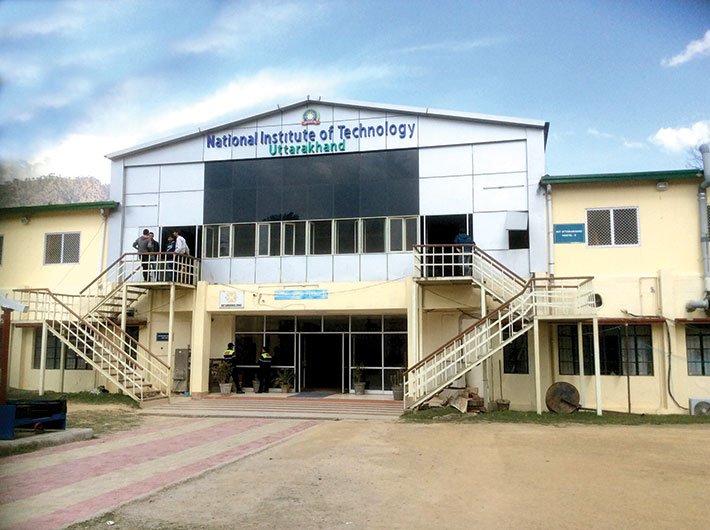NIT Uttarakhand is in a shambles. Half the students study in Jaipur, and a permanent campus seems nowhere in sight
After passing the 12th board exams in 2014, Vikas Kumar, of Madhepura in Bihar, took a year’s break to prepare for the engineering entrance exam. The hard work paid off and he managed to score high enough to qualify for admission to one of the prestigious National Institutes of Technology (NITs), where admission rates are as low as 1-2 percent of the applicants, making them only next in students’ preference to the IITs.
He was first assigned a seat at NIT Agartala, in Tripura. But after two months there, he opted to shift to NIT Uttarakhand, since he thought he’d adjust better to a place where Hindi was spoken, like in his native Bihar. He now rues the decision.
“It was a big mistake,” says Kumar, who is vice-president of the students union at NIT Uttarakhand. “The quality of an engineering college is determined by the infrastructure, faculty, workshops. This college fails on all parameters. We study in a tin-roofed shed. And what kind of electronics and electrical engineering lab can be run in a tin and plastic room?”
Everything seems to be wrong with NIT Uttarakhand, in Srinagar, about 113 km from Rishikesh, and between Devprayag and Rudraprayag on NH-7. Set up in 2009, with nine other NITs sanctioned that year, its first batch was admitted in 2010, and it now has 1,200 students on its rolls. But it operates from a campus shared with the state polytechnic. The 3.4 acre campus is divided into two, on the left from the entrance is the polytechnic, and on the right, the NIT Uttarakhand. The main building is shabby, its walls mouldy and ridden with algae. On the terrace, prefab plastic sheds with sheet roofs have been erected to create a hostel where up to six students share 8 x 10 foot rooms. A student shared an old photograph of a “lecture hall” with ugly, damp walls (now painted over after students protested in October). Some stairs are broken, the walls of the computer lab leak. “The infrastructure here is on its last legs,” says Kumar. “How long can they keep painting the walls and keep it alive with artificial respiration!”
Strangely for a technical institution of national importance, some of the labs of NIT Uttarakhand are 300 metres away, down towards Rishikesh. Students have to attend lectures at the campus and walk along NH-7, choc-a-bloc with the traffic to the pilgrimage spots in the Himalayas, to reach the labs, situated on a plot of the local Industrial Training Institute (ITI). On October 3 last year, Neelam Meena, an electronics and electrical engineering student, was hit by a car and left paralysed below the chest. This set off a protest by students that continued till December, demanding that the campus be moved to a safer location.
Meanwhile, advocate Abhijay Negi filed a PIL demanding an interim campus for students. On direction of the Uttarakhand high court, the union ministry of human resource development decided to move the campus to that of the Indian Drugs and Pharmaceuticals Ltd in Rishikesh. But the state government would not agree. Finally, it was decided to create a satellite campus, an odd coinage, for classes are held at the Malaviya National Institute of Technology – in Jaipur, Rajasthan! So now, some 700 students of NIT Uttarakhand (150 from first year courses, 280 from second year courses, and 270 from third year courses) actually live and attend classes in Jaipur.
In Srinagar, there’s also a problem of faculty: nobody wants to stay to teach there despite the highest pay package offered among all NITs. “Every year, we have new teachers,” says Anantha Kantre, a fourth year student of electronics and communication engineering. “The airport is 150 km away, we don’t have labs for robotics, rock engineering and so on because the premises are not shock/vibration resistant. We can’t order equipment, organise seminars or workshops. So teachers don’t want to come here.”
Troubled birth
When the NIT was first proposed, a permanent site was chosen in Sumari, a hilltop village about 15 km from Srinagar. So while classes began at the Srinagar campus, it was understood that eventually a full-fledged NIT would come up in Sumari. “The erstwhile Congress government chose the site very carefully: the village falls in Pauri Garhwal, but it’s very close to Tehri Garhwal. It was chosen to please both districts and both constitutencies. But this was done without any soil testing.”
Sumari is scenic, with hillsides dotted with pine and chinar. But when Dr HT Thorat, then director of NIT Uttarakhand, called for a survey of the site in March 2012, an IIT Roorkee team, under professors SY Kulkarni, MN Viladkar and Rathinam Anbalagan submitted that in parts “where the slope is very steep (greater than 45 degrees), no construction is possible. The elevation difference between the terraces in the remaining part of the steep will work out to be prohibitively large. For academic campus like that of NIT, this much elevation difference is not at all desirable.”
Later, studies were carried out by NIT Warangal and other technical institutions, but all of them gave the same verdict: Sumari was not suitable for having a technical educational institution.
So the institution continued to function in Srinagar, which saw more problems. In the devastating cloudburst of 2013, some buildings on the ITI campus (where the NIT has some of its labs) went under water as the Alaknanda burst its banks. To this day, those buildings remain unused. During the same time, as if to underline the unsuitability of the proposed Sumari campus, iron fencing erected by the National Building Construction Corporation (NBCC) at a cost of Rs 13.27 crore collapsed.
In October 2013, the union ministry of human resource development wrote the state government, asking for a new site for NIT Uttarakhand. But the government never made this request public. Instead, the then chief minister Harish Rawat went ahead and laid the foundation stone for the NIT in Sumari. The HRD ministry has written eight letters to the state government between 2013 and 2018, saying the Sumari site is unsuitable and, since there was little scope for expanding the Srinagar site into a full-fledged NIT, a new site should be allotted so that NIT Uttarakhand reaches its full potential.
Meanwhile, the NBCC had gone to work, estimating the cost of building the NIT premises in Sumari. The first phase cost, for a campus that would accommodate 1,500 students, was estimated at Rs 315.75 crore for building work, and Rs 188.26 crore for site development. Later, this was revised: since the Sumari site was sloped, it would require terracing and erection of concrete retaining walls, taking the cost up to Rs 1,200 crore. In December 2017, the 11th finance committee meeting for NIT Uttarakhand was held, in which officials of the HRD ministry, NIT, and the additional secretary of Uttarakhand, again revised the estimate to Rs 1,415 crore, including the levelling. And if the campus were to accommodate 2,400 students, as it would have to over the years, the first phase of construction would cost Rs 2,350 crore. Soil stabilisation, they estimated, would cost an additional Rs 925 crore. These details were shared by an official of the HRD ministry who did not wish to be named.
A tug-of-war is on between the HRD ministry and the state government. While the former wants a new site, given the unsuitability of the land and the high cost of building in Sumari, the state education minister, Dhan Singh Rawat, is unwilling to move the institution to some other place. At a press conference, he had said that the project aimed to improve the Garhwal region, so it could not be moved to the plains or to the Kumaon region.
The state has taken a strong line in the high court too: “The malafide intentions of the NIT administration can be assessed from the fact that a similar NIT is situated in Sikkim, where the concerned NIT administration has consented to build a permanent campus in an area of 80 acres very recently in the year 2018, which has got similar topology and geographical conditions as that of Srinagar, Garhwal.”
The Sikkim NIT, it might be noted, now runs from a temporary campus in Ravangla, in the South Sikkim district. A permanent campus is to come up in Khamdong, in the East Sikkim district, also hilly. However, it’s not known if there was any report on the unsuitability of the site (as in Sumari) for an engineering college.
Meanwhile, the villagers of Sumari are upset. They had donated around 100 acres to the government, hoping that the college would bring them better opportunities. “I completely understand their grief,” says advocate Negi. “The government not only took their land, it felled more than 800 trees, some of them as old as 100 years. Farmland, which the villagers donated to the government, has been lying uncultivated for the last eight years. They deserve compensation for this.”
On top of all that, local politicians have been instigating the villagers, saying those who don’t want development in the hills are preventing the college from coming up here. “But that’s not true,” says Negi. “The state government hid the reality from villagers – that the land was unsuitable for a college. It fooled the villagers to get votes.”
So although Uttarakhand now has an NIT in name, no one is happy. Not the students. Not the teachers. Not the locals. And not the villagers who gave up land in Sumari.
deexa@governancenow.com
(This article appears in the March 31, 2019 edition)

